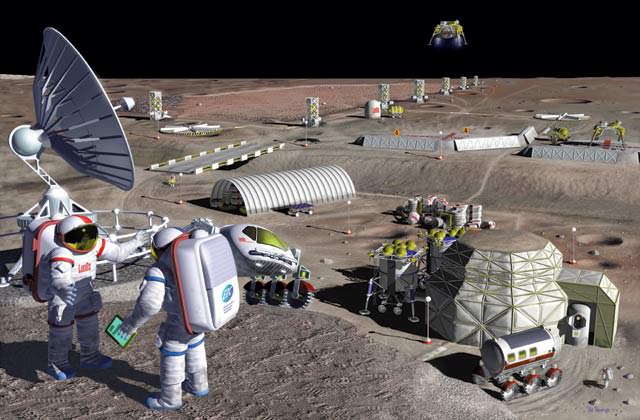40 years ago this week, the final Apollo mission, Apollo 17, launched to the Moon. In this new video produced by author Andrew Chaikin, geologist Paul Spudis of the Lunar and Planetary Institute explains why the Moon still beckons, “not just to visit, not just put a footprint there, but to go and understand it, to collect its rock and understand its history, to recover a lost chapter of a previous existence.” Right now, we understand just a small part of the history of our Solar System, and the Moon holds that history in its rocks. Additionally, newly found water on the Moon — estimates say about 600 million metric tons could be at the lunar poles — could allow us to “live off the land” in space.
A lunar mining facility harvests oxygen from the resource-rich volcanic soil of the eastern Mare Serenitatis. Credit: NASA/Pat Rawlings.


We just need the worlds’ politicians to commit!
Well done, and very interesting video.
600 million metric tons of “pure ice” at the North lunar Pole? Wow. Gives massive weight to the impressive volume of water on Earth!
Luna’s ancient surface indeed holds witness of a “missing chapter” of history, and “previous existence” of Earth-Moon System. But the “details” actually underlying the “broad outlines” of a “lost” chronicle, may not quite support the sketched story (so well narrated and beautifully animated here): Of how Earth’s time-faithful companion came to gently embrace Terra’s World of Life. The account may reveal a far less violence-wracked relationship, in the beginning. More than surprising, might Luna’s uncovered secrets boldly tell — and shed new-light on a host of aging worlds.
I think that if the primary interest is to study lunar geology then robotic telepresent systems are the best approach. Since it only take about 1.5 seconds for light to reach the moon the shorter delay time means a rover can be practically joysticked.
The question of human interaction in space and the prospect for a permanent human presence in space is a different issue. It will be necessary to demonstrate a real economic return for such activity. As I see it the most likely return is solar energy. Solar power satellites that require human presence to deploy and maintain them seem to be the most likely first step in this direction. If extending the grid off the Earth expands this may expand to semi-permanent stations in geosynchronous orbit. From there the human presence might extend further in time.
LC
An inspirational message! Funny how policy makers in DC haven’t figured it out yet? or made any attempt to change the mind-set ‘pork policy’. Finding water on the Moon is a TOTAL game changer! Sure we should, continue research in LEO and go to an asteroid, with robotics! But a lunar research colony should be our prime goal! COME ON PEOPLE! Let’s to go back to the Moon! Lets create new markets using the new materials and energy sources we find along the way! Lets get out of these economic BS duldrums…..